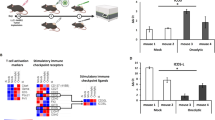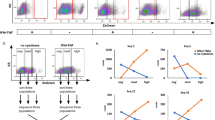Abstract
Transcriptional targeting of cytotoxic genes is an important way to control toxicity associated with gene transfer therapies, but supposedly, tissue-specific promoters are often either very weak and/or leaky. In addition, the phenotypic leakiness of such tissue-specific promoters is dependent upon the toxicity of the gene being used. Therefore, we devised a transcriptional feedback loop to restrict gene expression of very potent genes to melanoma cells. We screened different elements of the human tyrosinase promoter to find one which gave no detectable expression in non-melanoma cells but was active in melanoma cell lines. This weak, but highly tissue specific, element (Tyr-300) was then used as the basis for a transcriptional amplification feedback loop in which a consensus heat shock element (HSE) was cloned upstream of Tyr-300. The cytotoxic gene was cloned downstream of the HSE-Tyr-300 element along with a mutated form of the heat shock factor-1 (HSF-1) transcription factor, which no longer requires cellular stress to activate its trimerisation, nuclear localisation and transcriptional activation properties. Low levels of expression from Tyr-300 initiated expression of both the cytotoxic and the HSF-1 genes in melanoma cells. Gradual build up of HSF-1 amplified expression through binding to the HSE to give levels of cytotoxicity similar to that provided by a CMV promoter. However, no leakiness was observed in multiple non-melanoma cell lines tested. In addition to amplifying low levels of weak tissue-specific expression, the use of HSF-1 also leads to activation of endogenous stress-related genes such as hsp70. Induction of these genes, in the presence of cell killing by the cytotoxic gene, is a highly immunostimulatory event which enhances the antitumour vaccination effects of direct tumour cell destruction. Having demonstrated the compatibility of the component elements in plasmid form, we incorporated the feedback loop into a hybrid LTR-modified retroviral vector and confirmed that the system can be effective in the form of a viral vector. The format of the feedback loop described here could be exploited for any tissue type in which a highly tissue-specific element can be identified but which is itself too weak to be effective therapeutically.
This is a preview of subscription content, access via your institution
Access options
Subscribe to this journal
Receive 12 print issues and online access
$259.00 per year
only $21.58 per issue
Buy this article
- Purchase on SpringerLink
- Instant access to full article PDF
Prices may be subject to local taxes which are calculated during checkout







Similar content being viewed by others
References
Vile RG, Russell S, Lemoine N . Cancer gene therapy: Hard lessons and new courses Gene Therapy 2000 7: 2–8
Bateman A et al. Fusogenic membrane glycoproteins as a novel class of genes for the local and immune-mediated control of tumor growth Cancer Res 2000 60: 1492–1497
Diaz RM et al. A lentiviral vector expressing a fusogenic glycoprotein for cancer gene therapy Gene Therapy 2000 (in press)
Fielding AK et al. A hyperfusogenic gibbon ape leukaemia envelope glycoprotein: targeting a cytotoxic gene by ligand display Hum Gene Ther 2000 11: 817–826
Nettelbeck DM, Jerome V, Muller R . Gene therapy: designer promoters for tumour targeting Trends Genet 2000 17: 174–181
Shibata K et al. Identification of a cis-acting element that enhances the pigment cell-specific expression of the human tyrosinase gene J Biol Chem 1992 267: 20584–20588
Diaz RM, Eisen T, Hart IR, Vile RG . Exchange of viral promoter/enhancer elements with heterologous regulatory sequences generates targeted hybrid long terminal repeat vectors for gene therapy of melanoma J Virol 1998 72: 789–795
Bentley NJ, Eisen T, Goding C . Melanocyte-specific expression of the human tyrosinase promoter: activation by the microphtalmia gene product and role of the initiator Mol Cell Biol 1994 14: 7996–8006
Amin J, Ananthan J, Voellmy R . Key features of heat shock regulatory elements Mol Cell Biol 1988 8: 3761–3769
Goldenberg CJ et al. Purified human factor activates heat shock promoter in a HeLa cell-free transcription system J Biol Chem 1988 263: 19734–19739
Baler R, Dahl G, Voellmy R . Activation of human heat shock genes is accompanied by oligomerization, modification, and rapid translocation of heat shock transcription factor HSF1 Mol Cell Biol 1993 13: 2486–2496
Zuo J, Rungger D, Voellmy R . Multiple layers of regulation of huam heat shock transcription factor 1 Mol Cell Biol 1995 15: 4319–4330
Melcher AA et al. Tumor immunogenicity is determined by the mechanism of cell death via induction of heat shock protein expression Nat Med 1998 4: 581–587
Todryk S et al. Heat shock protein 70 induced during tumor cell killing induces Th1 cytokines and targets immature dendritic cell precursors to enhance antigen uptake J Immunol 1999 163: 1398–1408
Srivastava PK et al. Heat shock proteins come of age: primitive functions acquire new roles in an adaptive world Immunity 1998 8: 657–665
Melcher AA, Gough MJ, Todryk S, Vile RG . Apoptosis or necrosis for tumour immunotherapy – what's in a name? J Mol Med 2000 77: 824–833
Yasumoto K et al. Microphthalmia-associated transcription factor as a regulator for melanocyte-specific transcription of the human tyrosinase gene Mol Cell Biol 1994 14: 8058–8070
Menoret A, Patry Y, Burg C, Le Pendu J . Co-segregation of immunogenicity with expression of inducible but not constitutive hsp70 in rat colon carcinomas J Immunol 1995 155: 740–747
Suto R, Srivastava PK . A mechanism for the specific immunogenicity of heat shock protein-chaperoned peptides Science 1995 269: 1585–1588
Suzue K, Zhou X, Eisen HN, Young RA . Heat shock fusion proteins as vehicles for antigen delivery into the major histocompatibility complex class I presentation pathway Proc Natl Acad Sci USA 1997 94: 13146–13151
Tamura Y et al. Immunotherapy of tumors with autologous tumor-derived heat shock protein preparations Science 1997 278: 117–120
Blackburn RV, Galoforo SS, Corry PM, Lee YJ . Adenoviral-mediated transfer of a heat-inducible double suicide gene into prostate carcinoma cells Cancer Res 1998 58: 1358–1362
Huang Q et al. Heat-induced gene expression as a novel targeted cancer gene therapy strategy Cancer Res 2000 60: 3435–3439
Morgenstern JP, Land H . Advanced mammalian gene transfer: high titre retroviral vectors with multiple drug selection markers and a complementary helper-free packaging cell line Nucleic Acids Res 1990 18: 3587–3596
Cosset F-L et al. High-titer packaging cells producing recombinant retroviruses resistant to human serum J Virol 1995 69: 7430–7436
Melcer A, Murphy S, Vile RG . Heat shock protein expression in target cells infected by poorly detectable levels of replication competent virus contributes to the immunogenicity of adenoviral vectors Hum Gene Ther 1999 10: 1431–1442
Wong GG et al. Human GM-CSF: molecular cloning of the complementary DNA and purification of the natural and recombinant proteins Science 1985 228: 810–815
Naldini L et al. In vivo gene delivery and stable transduction of nondividing cells by a lentiviral vector Science 1996 272: 263–266
Zufferey R et al. Multiply attenuated lentiviral vector achieves efficient gene delivery in vivo Nat Biotechnol 1997 15: 871–875
Acknowledgements
We thank Toni L Higgins for expert secretarial assistance. This work was supported by Grant RO1 CA85931 from the National Cancer Institute and by the Mayo Foundation.
Author information
Authors and Affiliations
Rights and permissions
About this article
Cite this article
Emiliusen, L., Gough, M., Bateman, A. et al. A transcriptional feedback loop for tissue-specific expression of highly cytotoxic genes which incorporates an immunostimulatory component. Gene Ther 8, 987–998 (2001). https://doi.org/10.1038/sj.gt.3301470
Received:
Accepted:
Published:
Issue Date:
DOI: https://doi.org/10.1038/sj.gt.3301470
Keywords
This article is cited by
-
Plasmid Engineering for Controlled and Sustained Gene Expression for Nonviral Gene Therapy
Pharmaceutical Research (2006)
-
Adenovirus-mediated gene therapy for bladder cancer: efficient gene delivery to normal and malignant human urothelial cells in vitro and ex vivo
Gene Therapy (2003)
-
Intratumoral expression of a fusogenic membrane glycoprotein enhances the efficacy of replicating adenovirus therapy
Gene Therapy (2003)
-
Tumor antigen–specific induction of transcriptionally targeted retroviral vectors from chimeric immune receptor–modified T cells
Nature Biotechnology (2002)



